Republic of China Army
The Republic of China Army (ROCA), also known unofficially as the Taiwanese Army,[2] is the largest branch of the Republic of China Armed Forces. An estimated 80% of the ROC Army is located on Taiwan, while the remainder are stationed on the Penghu, Kinmen, Matsu, Dongsha and Taiping Islands.
| Republic of China Army | |||||||||||||||||||||||||
|---|---|---|---|---|---|---|---|---|---|---|---|---|---|---|---|---|---|---|---|---|---|---|---|---|---|
| 中華民國陸軍 Zhōnghuá Mínguó lùjūn (Mandarin) | |||||||||||||||||||||||||
_Logo.svg.png.webp) Emblem of the Republic of China Army | |||||||||||||||||||||||||
| Founded | 16 June 1924 (as the National Revolutionary Army) 25 December 1947 (as the Republic of China Army) | ||||||||||||||||||||||||
| Country | |||||||||||||||||||||||||
| Type | Army | ||||||||||||||||||||||||
| Role | Ground warfare | ||||||||||||||||||||||||
| Size | 130,000 (2019 est.) | ||||||||||||||||||||||||
| Part of | Republic of China Armed Forces | ||||||||||||||||||||||||
| Garrison/HQ | Longtan, Taoyuan, Republic of China | ||||||||||||||||||||||||
| Motto(s) | 親愛精誠 ("qīn ài jīng chéng, translated as "Devoted and Sincere Love") | ||||||||||||||||||||||||
| Colors | Gold Green | ||||||||||||||||||||||||
| March | 陸軍軍歌 ("Lùjūnjūngē"; "Liu̍k-kiûn Kiûn-kô"; English: "Army Anthem") | ||||||||||||||||||||||||
| Engagements | |||||||||||||||||||||||||
| Website | Chinese English | ||||||||||||||||||||||||
| Commanders | |||||||||||||||||||||||||
| Commander of the Army | |||||||||||||||||||||||||
| Deputy Commander of the Republic of China Army | |||||||||||||||||||||||||
| Deputy Commander of the Republic of China Army | |||||||||||||||||||||||||
| Insignia | |||||||||||||||||||||||||
| Roundel |   | ||||||||||||||||||||||||
| Flag | 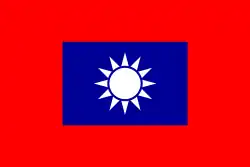 | ||||||||||||||||||||||||
| Aircraft flown | |||||||||||||||||||||||||
| Attack helicopter | AH-1W, AH-64E | ||||||||||||||||||||||||
| Cargo helicopter | CH-47SD, UH-60M | ||||||||||||||||||||||||
| Observation helicopter | OH-58D | ||||||||||||||||||||||||
| Trainer helicopter | TH-67A | ||||||||||||||||||||||||
| Utility helicopter | UH-60M | ||||||||||||||||||||||||
| Chinese name | |||||||||||||||||||||||||
| Traditional Chinese | 中華民國陸軍 | ||||||||||||||||||||||||
| Simplified Chinese | 中华民国陆军 | ||||||||||||||||||||||||
| |||||||||||||||||||||||||
Since the Chinese Civil War, no armistice or peace treaty has ever been signed, so as the final line of defense against a possible invasion by the People's Liberation Army (PLA), the primary focus is on defense and counterattack against amphibious assault and urban warfare.
Organization
_General_Hsu_Yen-pu_%E9%99%B8%E8%BB%8D%E4%B8%8A%E5%B0%87%E5%BE%90%E8%A1%8D%E7%92%9E_(01.17_%E7%B8%BD%E7%B5%B1%E4%B8%BB%E6%8C%81%E3%80%8C%E5%9C%8B%E8%BB%8D%E9%87%8D%E8%A6%81%E9%AB%98%E9%9A%8E%E5%B9%B9%E9%83%A8%E6%99%89%E4%BB%BB%E5%B8%83%E9%81%94%E6%8E%88%E9%9A%8E%E5%85%B8%E7%A6%AE%E3%80%8D_-_Flickr_id_49397561437).jpg.webp)


The ROC Army's current operational strength includes 3 armies, 5 corps. As of 2005, the Army's 35 brigades include 25 infantry brigades, 5 armoured brigades and 3 mechanized infantry brigades.[3][4][5] All infantry brigades stood down and transferred to Reserve Command after 2005.
This update reflects the ROCA order of battle at the conclusion of the Jinjing Restructuring Plan in 2008.
A new type of unit called defense team (守備隊) is being introduced. These are formed by elements of de-activated brigades under each area defense command. The strength of a defense team may vary from one or more reinforced battalions, making it roughly equal to a regiment. The team CO is usually a full colonel.[6]
In the event of war most of the high command would retreat to underground bunkers, tunnel complexes, and command posts.[7]
Republic of China Army Command Headquarters
- The ROC Army CHQ (中華民國國防部陸軍司令部) is headed by a 3-star general and is responsible for overall command of all ROC Army assets. Army GHQ is subordinate to the Chief of the General Staff (military), the Minister of National Defense (civilian) and the ROC President.
- Internal Units: Personnel, Combat Readiness and Training, Logistics, Planning, Communications, Electronics and Information, General Affairs, Comptroller, Inspector General, Political Warfare.
 Aviation and Special Forces Command (航空特戰指揮部)
Aviation and Special Forces Command (航空特戰指揮部)
- 601 Air Cavalry Brigade (original special force battalion assigned transferred back to 862nd Brigade)
- 602 Air Cavalry Brigade (original special force battalion assigned transferred back to 862nd Brigade)
- 603 Air Cavalry Brigade (this is a phantom unit, only exists on paper, no manpower, units, helicopters assigned)
- 101st Reconnaissance Battalion (better known as Sea Dragon Frogman, has a company station in Kinmen, Matsu, 3 in Penghu, and other frontline islands)
- Special Forces Command (特戰指揮部) In charge of 3 training centers
- Army Airborne Training Center (大武營「陸軍空降訓練中心」)
- Army Special Forces Training Center (谷關「陸軍特戰訓練中心」)
- Army Winter and Mountain Training Center (武嶺寒訓中心)
- Special Forces Command (originally 862nd Special Operation Brigade)
- Special Force 1st Battalion
- Special Force 2nd Battalion
- Special Force 3rd Battalion
- Special Force 4th Battalion
- Special Force 5th Battalion
 6th Army Corps (第六軍團指揮部): Northern Taiwan
6th Army Corps (第六軍團指揮部): Northern Taiwan
 Guandu Area Command
Guandu Area Command Lanyang Area Command
Lanyang Area Command 269 Mechanized Infantry Brigade
269 Mechanized Infantry Brigade 542 Armor Brigade
542 Armor Brigade 584 Armor Brigade
584 Armor Brigade- 21 Artillery Command
- 53 Engineer Group
- 73 Signals Group
- 33 Chemical Warfare Group[8]
 8th Army Corps (第八軍團指揮部): Southern Taiwan
8th Army Corps (第八軍團指揮部): Southern Taiwan
- 333 Mechanized Infantry Brigade
 564 Armor Brigade
564 Armor Brigade- 43 Artillery Command
- 54 Engineer Group
- 75 Signals Group
- 39 Chemical Warfare Group
 10th Army Corps (第十軍團指揮部): Central Taiwan
10th Army Corps (第十軍團指揮部): Central Taiwan
- 234 Mechanized Infantry Brigade (will receive CM-32 "Clouded Leopard" wheeled IFV beginning of 2011)[9]
 586 Armor Brigade
586 Armor Brigade- 58 Artillery Command
- 52 Engineer Group
- 36 Chemical Warfare Group
- 74 Signals Group
-
- Hualien (花蓮) Defense Team
- Taitung (台東) Area Command
 Kinmen Defense Command (金門防衛指揮部)
Kinmen Defense Command (金門防衛指揮部)
 Penghu Defense Command (澎湖防衛指揮部)
Penghu Defense Command (澎湖防衛指揮部)
- 1 Armored Battalion, 1 Armored Infantry Battalion, 1 Armored Cav Battalion, 1 mixed Artillery Battalion.
 Matsu Defense Command (馬祖防衛指揮部)
Matsu Defense Command (馬祖防衛指揮部)
- Nangan (南竿) Defense Team
- Beigan (北竿) Defense Team
- Juguang (莒光) Defense Team
 Dongyin Area Command (東引地區指揮部)
Dongyin Area Command (東引地區指揮部)
- Logistics Command (後勤指揮部)
- Education, Training and Doctrine Command (教育訓練暨準則發展指揮部)
- Republic of China Military Academy, Training & Command Schools, Chemical Warfare Corps, Engineering Corps, Arsenal Development.
 Armed Force Reserve Command (後備指揮部)
Armed Force Reserve Command (後備指揮部)
- 11 active infantry brigades, 24 Reserve brigades (Activated only in time of war)
ROC Army's former Army Missile Command was transferred to ROC Air Force in 2006.

Ranks
Commissioned officer ranks
The rank insignia of commissioned officers.
| Rank group | General / flag officers | Senior officers | Junior officers | Officer cadet | ||||||||||||||||||||||||||||||||
|---|---|---|---|---|---|---|---|---|---|---|---|---|---|---|---|---|---|---|---|---|---|---|---|---|---|---|---|---|---|---|---|---|---|---|---|---|
 |
 |
 |
 |
 |
 |
 |
 |
 |
 |
|||||||||||||||||||||||||||
| 一級上將 It-kip siōng-chiòng |
二級上將 Jī-kip siōng-chiòng |
中將 Tiong-chiòng |
少將 Siáu-chiòng |
上校 Siōng-hāu |
中校 Tiong-hāu |
少校 Siáu-hāu |
上尉 Siōng-ùi |
中尉 Tiong-ùi |
少尉 Siáu-ùi |
軍校生 Jūnxiào shēng | ||||||||||||||||||||||||||
Other ranks
The rank insignia of non-commissioned officers and enlisted personnel.
| Rank group | Senior NCOs | Junior NCOs | Enlisted | |||||||||||||||||||||||||||||||||
|---|---|---|---|---|---|---|---|---|---|---|---|---|---|---|---|---|---|---|---|---|---|---|---|---|---|---|---|---|---|---|---|---|---|---|---|---|
 |
 |
 |
 |
 |
 |
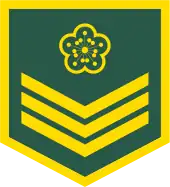 |
 |
 | ||||||||||||||||||||||||||||
| 一等士官長 Yīděng shìguānzhǎng |
二等士官長 Èrděng shìguānzhǎng |
三等士官長 Sānděng shìguānzhǎng |
上士 Shàngshì |
中士 Zhōngshì |
下士 Xiàshì |
上等兵 Shàngděngbīng |
一等兵 Yīděngbīng |
二等兵 Èrděngbīng | ||||||||||||||||||||||||||||
Training
The Republic of China Military Academy, established in 1924, trains officers for the army in a four-year collegiate course of study, after which they graduate with an officer's commission and a bachelor's degree.
History

The Republic of China Army originated from Chinese National Revolutionary Army, which was founded by Sun Yat-sen's Kuomintang (KMT) in 1924, when the Whampoa Military Academy was established with Soviet military assistance. Whampoa Military Academy, which was presided by Chiang Kai-shek, was tasked with the objective of training a professional Chinese revolutionary army (革命軍人) to unify China during the Warlord Era. It participated in the Northern Expedition, the Second Sino-Japanese War (during World War II) and the Chinese Civil War before withdrawing with the ROC government to Taiwan in 1949.
After 1949, the ROC Army has participated in combat operations on Kinmen and the Dachen Archipelago against the PLA in the Battle of Kuningtou, and in the First and Second Taiwan Strait Crisis. In addition to these major conflicts, ROCA commandos were regularly sent to raid the Fujian and Guangdong coasts. Until the 1970s, the stated mission of the Army was to retake the mainland from the People's Republic of China. Following the lifting of martial law in 1987 and the democratization of the 1990s, the mission of the ROC Army has been shifted to the defense of Taiwan, Penghu, Kinmen and Matsu from a PLA invasion.
With the reduction of the size of the ROC armed forces in recent years, the Army has endured the largest number of cutbacks as ROC military doctrine has begun to emphasize the importance of offshore engagement with the Navy and Air Force. Subsequent to this shift in emphasis, the ROC Navy and Air Force have taken precedence over the ROC Army in defense doctrine and weapons procurement.[11] Recent short-term goals in the Army include acquisition and development of joint command and control systems, advanced attack helicopters and armored vehicles, Multiple Launch Rocket System and field air defense systems. The Army is also in the process of transitioning to an all volunteer force.[5]
During the COVID-19 pandemic Army chemical warfare units were used to disinfect public areas and to do spot disinfections around known disease clusters. In January 2021 the 33rd Chemical Warfare Group was deployed to Taoyuan City to deal with a cluster of infections around a hospital there.[12]
Equipment
From the 1990s onwards, the Republic of China Army launched several upgrade programmes to replace outdated equipment with more advanced weapons, also increasing its emphasis on forces that could be rapidly deployed and were suited for combat in Taiwan's heavily urbanized environment. Orders were placed with the United States for M60A3 Patton tanks, M109A5 "Paladin" howitzers and AH-1W SuperCobra attack helicopters, as well as updating existing equipment.
Along with the other ROC military branches, the ROC Army has extensive experience in the construction and utilization of tunnels and bases gained during the People's Republic of China's bombardments of Kinmen and Matsu during the Cold War and many facilities are rumoured to be located underground in undisclosed locations.
The U.S. Government announced on October 3, 2008, that it plans to sell $6.5 billion worth of arms to Taiwan ending the freeze of arms sales to Taiwan. Amongst other things, the plans include $2.532 billion worth of 30 AH-64D Apache Longbow Block III Attack helicopters with night-vision sensors, radar, 173 Stinger Block I air-to-air missiles and 1000 AGM-114L Hellfire missiles.[13] and 182 Javelin missiles will also be available with 20 Javelin command launchers and is estimated to cost $47 million.[14]
On January 29, 2010, US Government announced 5 notifications to US Congress for arms sales to Taiwan. Of the total 6.392 billion US dollars in the 5 announcements, ROC Army will receive 60 UH-60M and other related things for cost of 3.1 Billion.[15]
Helicopters

In July 2007 it was reported that the ROC Army would request the purchase of 30 AH-64E Apache Guardian attack helicopters from the US in the 2008 defence budget.[16] In October 2015 it was announced that 9 AH-64E had been grounded due to oxidation of components in the helicopters' tail rotor gearboxes and comprehensive safety checks were made on all Apaches. The 2008 defense budget also listed a request for 60 UH-60M Black Hawk helicopters as a partial replacement for the UH-1Hs currently in service.[17]
Main battle tanks

As of 2019, the ROC army has 480 M60A3s, 450 CM11s (modified M48 turrets mated to M60 chassis), and 250 CM12s (CM-11 turrets mated to M48 hulls). The design and technology used in the tanks date back to the 1940s and 1950s, including their 105mm rifled gun and utilizing traditional steel armor plating rather than composite materials used in modern armored fighting vehicles. It is expected that the majority of the ROC Army's armored units would continue to be equipped with legacy tanks in upgraded form after the army acquires the newer modern tanks.[18] As of 2015, some CM11 tanks are observed to be upgraded with explosive reactive armor around the turret and hull.[19]
In October 2017, Taiwan announced an upgrade program for 450 M60A3s consisting of replacing the main gun with a new 120 mm weapon, as well as upgrading the ballistics computer, turret hydraulics, and other systems. Testing and evaluation are expected to be completed in 2019 and application of new features to start in 2020.[20] However, in July 2018 the Ministry of National Defense renewed its interest in acquiring Abrams, and had set aside US$990 million to purchase 108 M1A2s while modernization of existing M60A3s in service continues.[21]
On June 7, 2019, Taiwan's Ministry of National Defense confirmed that Taiwan has signed a $2 billion weapons deal with the Trump administration, which includes a purchase of 108 M1A2T (M1A2C export variant for Taiwan) Abrams battle tanks. Taiwanese defense officials intend to use the M1A2T Abrams battle tank to replace its army's M60A3 and M48H CM11 tanks.[22][23] On July 8, 2019, the U.S. State Department approved the sale of new M1A2T Abrams tanks to Taiwan despite criticism and protest of the deal from the People's Republic of China (PRC). The deal includes 122 M2 Mounted Machine Guns, 216 M240 machine guns, 14 M88A2 HERCULES vehicles, and 16 M1070A1 Heavy Equipment Transporters. General Dynamics Land Systems will build the tanks at Anniston Army Depot, Alabama, and at Joint Systems Manufacturing Center in Lima, Ohio. The final signing of the Letter of Offer and Acceptance (LOA) was confirmed on December 21, 2019.[24] The tanks represent the first sale of new tanks to the ROC Army in decades from the US. Surplus M1A1 tanks were previously rejected by previous US administrations, including George W. Bush in 2001.[25] Current ROC tanks include used M60A3 tanks and locally manufactured M48 tanks in which the initial variants were first produced between the 1950s and 1960s.[26][27][28]
Some criticisms were made of these M1 Abrams purchases, some analysts expressed that Taiwan's terrain and some of its bridges and roads are unsuitable for the 60-tonne M1A2. However, Taiwan's current tanks have older 105-millimeter guns that may not be able to readily penetrate the frontal armor of modern People's Liberation Army (PLA) Type 96 and Type 99 tanks, which can easily penetrate the Patton's old-fashioned steel armor with their 125-millimeter guns. The M1A2T tank's 120-millimeter gun is capable of destroying PLA tanks without reliance on anti-tank missiles.[29] Moreover, tanks can be used as mobile reserves for counterattacks against PLA beach landings, which was successful during the Battle of Guningtou.[30] ROC Army Chief of Staff, Yang Hai-ming, said that China's best tank, the heavy Type 99 tank, would not be able to be transported in an amphibious invasion during a potential war with Taiwan and the PLA would have to rely on the much lighter 20-ton Type 63A tanks. Due to this logistics issue for the PLA there is less concern about the M1A2T tanks having to deal with China's most modern tanks during an amphibious invasion.[31]
Infantry vehicles

CM-32 Yunpao, an 8x8 armoured personnel carrier locally manufactured, will replace ageing M113s and V-150 armoured vehicles. It is a modular vehicle platform capable of accepting various configurations for specific combat requirements. As of 2019, an IFV version of Yunpao armed with Orbital ATK 30mm Mk44 Bushmaster II cannons, CM-34, is planned for production.[32] Production of a version with a 105-mm assault gun, which is modeled on that of the CM-11 Brave Tiger main battle tank, is also scheduled to be completed by 2023.[33]
Air defense

Long and medium range air defense systems are operated by the Republic of China Air Force with the Army assuming much of the SHORAD mission. The most modern air defense system of the Army is the US-made Avenger.[34]
The ROCA is in the process of fielding the Surface-to-Air TC-2 medium range air defense system.[35] Development of a surface launched TC-2 began with the ROCN in 1994.[36]
On June 7, 2019, Taiwan's Ministry of National Defense confirmed that Taiwan has signed a $2 billion weapons deal with the Trump administration, which includes a purchase of "250 surface-to-air Stinger missile systems."[22] Taiwan's ROC Army already has 2,223 Stinger missile systems.
Artillery
On September 23, 2019, former Defense Minister Yen De-fa (嚴德發) confirmed the Republic of China Armed Forces has requested the purchase of M109A6 Paladin self-propelled howitzers from the United States. On August 4, 2021, the Biden administration approved a potential $750 million sale of 40 M109A6 self-propelled howitzers and other supporting equipment, including up to 1,698 kits for precision-guided munitions.[37][38][39][40][41][42] However, the M109A6 is reportedly delayed until 2026 or later due to crowded production line forcing the Republic of China Armed Forces to look for alternatives.[43][44] As of March 2023, the Republic of China Armed Forces is reportedly attempting to acquire hundreds of missile trucks and self-propelled howitzers from the Czech Republic.[45]
As of 2019, the ROC Army's current artillery in service consists of M109A2 and M109A5 systems, 8 inch M110A2 self-propelled howitzers and 155mm M114 towed howitzers. These systems have exceeded their service life with the oldest being the M114, which has been in service for 68 years, while the youngest artillery system, the M109A5, has been in service for 21 years. The last artillery system that entered service is the M109A5s, which are ordered in 1996 and taken delivery in 1998.

Gallery
 ROC Army sharpshooter team
ROC Army sharpshooter team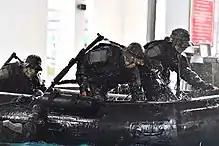 ROC Army 101st Amphibious Reconnaissance Battalion Training during Amphibious Landing Exercise
ROC Army 101st Amphibious Reconnaissance Battalion Training during Amphibious Landing Exercise A military frogman of the 101st Amphibious Reconnaissance Battalion
A military frogman of the 101st Amphibious Reconnaissance Battalion Chemical Safety Persons Cleaning Truck
Chemical Safety Persons Cleaning Truck ROCA Emergency Command Car
ROCA Emergency Command Car ROCA Microwave Broadcasting Van (Ford F250 chassis)
ROCA Microwave Broadcasting Van (Ford F250 chassis).jpg.webp) Military equipment on a train
Military equipment on a train ROCA Satellite Telecommunication Vehicle (Ford E-Series van)
ROCA Satellite Telecommunication Vehicle (Ford E-Series van)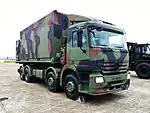 ROCA Mobile Water Filter Truck (Mercedes-Benz Actros chassis)
ROCA Mobile Water Filter Truck (Mercedes-Benz Actros chassis) MAN 35ton Heavy Transporter
MAN 35ton Heavy Transporter ROCA Special Assault Vehicle
ROCA Special Assault Vehicle ROCA Type 97 NBC Detection (Daimler Truck Unimog) Truck
ROCA Type 97 NBC Detection (Daimler Truck Unimog) Truck ROCA AH-1W
ROCA AH-1W An ROCA UH-1H 379 taking off from ROCMA Ground
An ROCA UH-1H 379 taking off from ROCMA Ground UH-60M
UH-60M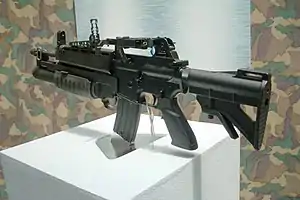 Type 86 carbine
Type 86 carbine Generator of T-82 20mm Twin Cannon
Generator of T-82 20mm Twin Cannon Engineering Equitment of Center Taiwan Reserve Training Center
Engineering Equitment of Center Taiwan Reserve Training Center LAADS Housed in S-280 Shelter on Truck
LAADS Housed in S-280 Shelter on Truck ROCA Double-modes Infrared Biological Detector
ROCA Double-modes Infrared Biological Detector T4-86 Light Sterilizer with Bath Screen
T4-86 Light Sterilizer with Bath Screen Wire dispenser
Wire dispenser Visitors with ROCA Officer Photoing above Engineering Bridge
Visitors with ROCA Officer Photoing above Engineering Bridge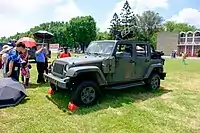 Military Light Tactical Vehicle Type B
Military Light Tactical Vehicle Type B ROCA M88A1 RV
ROCA M88A1 RV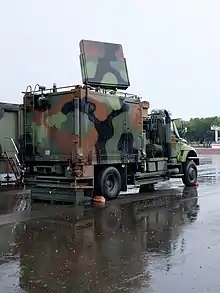 CS/MPQ-90 on a Navistar 7000 series truck
CS/MPQ-90 on a Navistar 7000 series truck Bistatic Radar Passive Receiver Systen Display at Military Academy Ground
Bistatic Radar Passive Receiver Systen Display at Military Academy Ground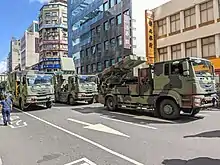 Ground based Sky Sword 2 battery
Ground based Sky Sword 2 battery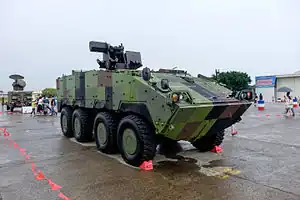 CM-32 APC
CM-32 APC CM-32, 30mm Bushmaster cannon armed variant of the CM-32
CM-32, 30mm Bushmaster cannon armed variant of the CM-32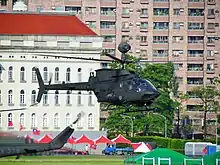 OH-58D Kiowa scout helicopter
OH-58D Kiowa scout helicopter
See also
- Republic of China Army rank insignia
- Ministry of National Defense (Republic of China)
- Republic of China Armed Forces
- Orders, decorations, and medals of the Republic of China
- Political status of Taiwan
- Santikhiri, a town in Thailand settled by remnants of the 93rd Division
References
- "Joint Statement Issued by Partners at the Counter-ISIL Coalition Ministerial Meeting". Archived from the original on 2017-06-02. Retrieved 2018-02-02.
- Bardenhagen, Klaus (2021). "Taiwan's army 'ill-prepared' for potential Chinese attack". Deutsche Welle.
The morale and training of the Taiwanese army will probably play a major role in determining whether Taiwan really is ready to defend itself in an emergency.
- "Speculative ROC Army ORBAT". Taiwanmilitary.org. Archived from the original on 2007-09-28. Retrieved 2006-03-08.
- "ROC Army". GlobalSecurity.org. Archived from the original on 2006-03-08. Retrieved 2006-03-08.
- "2004 National Defense Report" (PDF). ROC Ministry of National Defense. 2004. Archived from the original (PDF) on 2006-03-11. Retrieved 2006-03-05.
- August 12, 2007. Retrieved Sept 16, 2009 Archived September 28, 2007, at the Wayback Machine
- Everington, Keoni (28 January 2021). "List of Taiwan targets for China's bombers revealed". www.taiwannews.com.tw. Taiwan News. Retrieved 28 January 2021.
- Yu, Matt; Teng-yi, Wang; Lim, Emerson. "Chemical soldiers: Taiwan's unsung protectors in fight against COVID". Focus Taiwan. Retrieved 8 July 2021.
- "ROC Army 602nd Air Cav Brigade 2010 Open Base Exercise In The Rain". wretch.cc/blog/. Archived from the original on 2011-01-14. Retrieved 2010-11-14.
- "Lùhǎikōng jūnfú zhì tiáolì fù tú" 陸海空軍服制條例附圖 [Drawings of the Uniform Regulations of the Army, Navy and Air Force] (PDF). Gazette of the Presidential Palace (6769): 65–67. 7 November 1996. Archived from the original (PDF) on 6 March 2017. Retrieved 15 August 2022.
- Roy, Denny (2003). "Taiwan's Threat Perceptions: The Enemy Within" (PDF). Asia-Pacific Center for Security Studies. Archived (PDF) from the original on 2006-04-22. Retrieved 2006-03-09.
{{cite journal}}: Cite journal requires|journal=(help) See "Reforming the Armed Forces", page 5. - Everington, Keoni (21 January 2021). "Taiwan deploys chemical warfare troops to disinfect Taoyuan". www.taiwannews.com.tw. Taiwan News. Retrieved 21 January 2021.
- "Archived copy" (PDF). Archived from the original (PDF) on 2009-02-27. Retrieved 2009-07-18.
{{cite web}}: CS1 maint: archived copy as title (link) - Shanker, Thom (2008-10-04). "Arms Deal to Taiwan Riles China". The New York Times. ISSN 0362-4331. Archived from the original on 2020-01-11. Retrieved 2020-01-11.
- "USDA New Release" (PDF). dsca.mil. 2010-01-29. Archived from the original (PDF) on 2011-07-21. Retrieved 2010-01-29.
- "Taiwan to Buy Apaches to Counter China Threat". Defense News. 2007-07-09. Archived from the original on 2012-06-30. Retrieved 2007-10-07.
- "Report says Taiwan sold 1 billion rifle bullets to U.S." Archived from the original on 2007-11-09. Retrieved 2007-11-05.
- "Army to upgrade Patton tanks to build up forces - Taipei Times". 9 July 2019. Archived from the original on 2019-08-01. Retrieved 2019-08-01.
- "CM-11 Brave Tiger (M48H) Main Battle Tank (MBT) - Taiwan". Archived from the original on 2018-11-09. Retrieved 2019-09-26.
- Giving up on Abrams tank acquisition, Taiwan moves to upgrade its M60A3 tanks - Defensenews.com, 6 October 2017
- Taiwan seeking to buy M1A2 Abrams MBTs from US Archived 2018-09-21 at the Wayback Machine - Jane's 360, 11 July 2018
- Carlo Muñoz, "Defying China, U.S. to sell new tanks, anti-aircraft missiles to Taiwan in $2B deal" Archived 2019-06-09 at the Wayback Machine, The Washington Times, June 7th 2019
- "Taiwan Likely to Buy over 100 US' M1A2X Main Battle Tanks This Year". Archived from the original on 2019-06-21. Retrieved 2019-06-21.
- "Taiwan and U.S. Sign agreement for F-16V fighter jet deal". 21 December 2019. Archived from the original on 2019-12-21. Retrieved 2019-12-21.
- "China Will be Mad: Taiwan Will Get M1 Abrams Tanks from America (And More)". 2019-07-10.
- "US State Dept. OKs possible $2 billion Abrams tank sale to Taiwan". 2019-07-09.
- "U.S. State Department approves possible $2.2 billion arms sale to Taiwan". Reuters. 2019-07-09. Archived from the original on 2019-07-09. Retrieved 2019-07-09.
- "Taipei Economic and Cultural Representative Office in the United States (TECRO) – M1A2T Abrams Tanks and Related Equipment and Support | The Official Home of the Defense Security Cooperation Agency". Dsca.mil. 2019-07-08. Archived from the original on 2020-02-22. Retrieved 2020-01-11.
- "Will Taiwan Get the New F-16V Fighters It Desperately Wants?". 2019-07-20.
- "Taiwan's Tanks Managed to do What Hitler's Mighty Panzers Failed to do at Normandy". 2017-02-26. Archived from the original on 2018-07-17. Retrieved 2019-07-21.
- "Taiwan's US-made M1A2T Abrams 'More Capable' than Chinese Type 99 Tanks". www.defenseworld.net. Sep 26, 2019. Archived from the original on Oct 6, 2021. Retrieved 23 August 2023.
- "Taiwainese CM-34 armored vehicles production to start this year | January 2019 Global Defense Security army news industry | Defense Security global news industry army 2019 | Archive News year". Archived from the original on 2019-09-26. Retrieved 2019-09-26.
- "Taiwan set to develop two indigenous armored vehicles by end 2023 - Focus Taiwan". Archived from the original on 2019-09-21. Retrieved 2019-09-26.
- "The Antelope". missiledefenseadvocacy.org. Missile Defense Advocacy Alliance. Archived from the original on 21 July 2019. Retrieved 21 July 2019.
- "IDEX 2019: Land-based TC-2 air defense missile system by NCSIST". www.armyrecognition.com. Army Recognition. Archived from the original on 21 July 2019. Retrieved 21 July 2019.
- "Tien Chien-2N (TC-2N)". missiledefenseadvocacy.org. Missile Defense Advocacy Association. Archived from the original on 21 July 2019. Retrieved 21 July 2019.
- "Taipei Economic and Cultural Representative Office in the United States (TECRO) – 155mm M109A6 Paladin Medium Self-Propelled Howitzer System | Defense Security Cooperation Agency".
- "U.S. Approves potential sale of howitzers to Taiwan - Pentagon". Reuters. 5 August 2021.
- "Biden administration approves first arms sale to Taiwan". 4 August 2021.
- Capaccio, Anthony (August 5, 2021) [August 4, 2021]. "First Taiwan Arms Sale in Biden Administration Is Approved". Bloomberg b. Retrieved 2022-04-12.
- "Minister confirms Paladin howitzer purchase request - Taipei Times". Archived from the original on 2019-09-23. Retrieved 2019-09-23.
- "Taiwan set to purchase upgraded artillery from United States". 2019-09-23. Archived from the original on 2019-09-23. Retrieved 2019-09-23.
- "Taiwan considers alternatives after U.S. Informs of howitzer delay". Reuters. 2 May 2022.
- "Document reveals $14 billion backlog of US defense transfers to Taiwan". 14 April 2022.
- "Taiwan nearing deal on missile trucks, self-propelled artillery from Czech Republic | Taiwan News | 2023-03-28 13:12:00". 28 March 2023.
External links
- ROC Army webpage (in English)